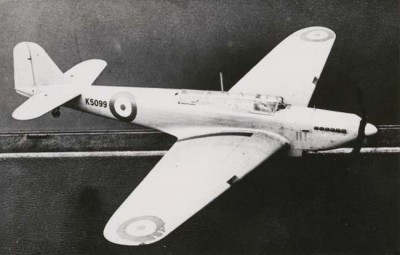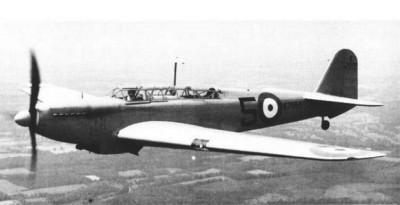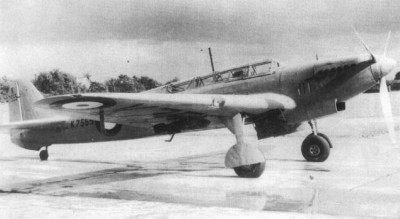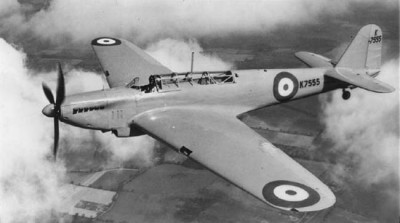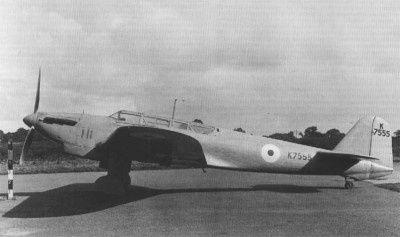| Název: Name: | Fairey P.4/34 | Fairey P.4/34 |
| Originální název: Original Name: | Fairey P.4/34 | |
| Kategorie: Category: | bombardovací letoun | bomber aeroplane |
| Výrobce: Producer: | DD.MM.1935-19.04.1937 Fairey Aviation Co. Ltd., Stockport | |
| Období výroby: Production Period: | DD.MM.1935-19.04.1937 | |
| Vyrobeno kusů: Number of Produced: | 2 | |
| První vzlet: Maiden Flight: | 13.01.1937 1st prototype 19.04.1937 2nd prototype | |
| Osádka: Crew: | 2 | |
| Základní charakteristika: Basic Characteristics: | ||
| Vzlet a přistání: Take-off and Landing: | CTOL - konvenční vzlet a přistání | CTOL - conventional take-off and landing |
| Uspořádání křídla: Arrangement of Wing: | jednoplošník | monoplane |
| Uspořádání letounu: Aircraft Concept: | klasické | conventional |
| Podvozek: Undercarriage: | zatahovací | retractable |
| Přistávací zařízení: Landing Gear: | kola | wheels |
| Technické údaje: Technical Data: | ||
| Hmotnost prázdného letounu: Empty Weight: | 2905 kg | 6405 lb |
| Vzletová hmotnost: Take-off Weight: | 3986 kg | 8787 lb |
| Maximální vzletová hmotnost: Maximum Take-off Weight: | 4600 kg | 10141 lb |
| Rozpětí: Wingspan: | 14.430 m | 47ft 4in |
| Délka: Length: | 12.190 m | 40 ft |
| Výška: Height: | 4.290 m | 14 ft 1 in |
| Plocha křídla: Wing Area: | 31.77 m2 | 342 ft2 |
| Plošné zatížení: Wing Loading: | 125.464 kg/m2 | 25.7 lb/ft2 |
| Pohon: Propulsion: | ||
| Kategorie: Category: | pístový | piston |
| Počet motorů: Number of Engines: | 1 | |
| Typ: Type: | Rolls-Royce Merlin I kapalinou chlazený vidlicový dvanáctiválec o vzletovém výkonu 597 kW při 3 000 ot/min a bojovém výkonu 768 kW při 3 000 ot/min v h= 1 676 m při plnícím tlaku 0,41 barů (307,526 mm Hg). Vrtule trojlistá stavitelná. | Rolls-Royce Merlin I twelve-cylinder liquid-cooled Vee engine rated 800 hp at 3,000 rpm for take-off and combat power 1,030 hp at 3,000 rpm at 5,500 ft boost +6 psi, driving a three-blade variable-pitch propeller. |
| Objem palivových nádrží: Fuel Tank Capacity: | ? | ? |
| Výkony: Performance: | ||
| Maximální rychlost: Maximum Speed: | 455.4 km/h v 4572 m | 283 mph in 15000 ft |
| Cestovní rychlost: Cruise Speed: | 394.3 km/h v 3048 m | 245 mph in 10000 ft |
| Rychlost stoupání: Climb Rate: | 6.1 m/s | 1200 ft/min |
| Čas výstupu na výšku: Time to Climb to: | ? min do ? m | ? min to ? ft |
| Operační dostup: Service Ceiling: | 8108 m | 26600 ft |
| Dolet: Range: | 1480.6 km | 920 mi |
| Maximální dolet: Maximum Range: | ? km | ? mi |
| Výzbroj: Armament: | 1x pevný kulomet Browning Mk.II ráže 7.7 mm 1x pohyblivý kulomet Vickers K ráže 7.7 na konci kabiny Pumový náklad: 2x puma o hmotnosti 113 kg | One fixed, forward-firing .303 in Browning MK.II machine-gun one flexible rearward-firing 0.303 inch Vickers K machine-gun in rear cabin. Bomb load: Two 250 lb bombs externaly |
| Uživatelské státy: User States: | | |
| Poznámka: Note: | Viz historie typu. | In 1934 the Air Ministry issued Specification P.4/34 which called for a light bomber that could also be deployed in a close-support role. The P.4/34 design was a low-wing all-metal monoplane, powered by a Rolls-Royce Merlin engine, with a crew of two accommodated in tandem under a long-glazed canopy. Its layout was similar to Fairey's earlier Battle bomber, but the P.4/34 was smaller and had a wide track, inwards-retracting undercarriage. The aircraft was stressed for dive bombing, as required by the specification, and carried its load of two 250 lb bombs underwing (the competing Hawker aircraft had an internal bomb bay). Two Fairey P.4/34s were ordered, with the first (serial K5099) flying on 13 January 1937.[1] The Hawker prototype followed on 10 March 1937. The Hawker was deemed superior; however, the demand for a light bomber had changed, and it would enter service as a target tug. The P.4/34 would serve as the basis for a two-seat, long-range, carrier-based fighter for the Fleet Air Arm to meet the requirements of Specification O.8/38. The second prototype P.4/34 (serial K7555) was therefore modified with, among other things, a reduced-span wing and lowered tailplane as an aerodynamic prototype for the Fulmar. It was later used to test retractable Fairey-Youngman flaps to be used on the Fairey Firefly fighter. |
| Zdroje: Sources: | Francis K. Mason, The British Bomber since 1914, UK, London, Putnam Aeronautical Books, 1994. ISBN 0-85177-861-5. Hugh A. Taylor, Fairey Aircraft since 1915, UK, London, Putnam, 1974, ISBN 0-370-00065-X. http://www.airwar.ru/enc/bww2/faireyp4-34.html www.aviastar.org www.all-aero.com | |
Fairey P.4/34
the History of type.
The british ministry of aviation (Air Ministry) has drawn up 12. November 1934 the specifications marked P.4/34. Specification required a lightweight two-seater bomber, who was on duty to replace the already old biplane aircraft Hawker Hart and at the same time should suitably complement the heavier light bomber Fairey Battle, which was the three-digit and took even greater bomb load, than what was required of the specific characteristics of P.4/34. The new aircraft was to be a monoplane with retractable landing gear, bomb load should be only 227 kg. The aircraft was to be powered by the Rolls-Royce Merlin F and the maximum speed should be at least 322
km/h.
The above specifications have answered your projects of the company Bristol Aeroplane Co., Ltd., Fairey Aviation Co. Ltd. and Hawker Aircraft Ltd., after the submission of their projects, were all negotiated orders for the construction of prototypes. In the company Fairey project took the chief designer Marcel Jules Odilon Lobell, whose work was also mentioned a light bomber Fairey Battle. The newly formed bomber with its predecessor and quite similar, but the prototype P.4/34 was technologically more advanced and also aerodynamic design was more sophisticated. Built and zalétány were only two prototypes, serial numbers K5099 and K7555, which participated in the factory tests. The first of them flown by factory test pilot Flight Lieutenant Christopher Stainbank Staniland on 13. January 1937. The second prototype flew on 19. April 1937. Factory tests are carried out satisfactorily on the whole, the identified deficiencies have been quickly removed. During the tests it was found that both prototypes could in many ways compete with more siblings Fairey Battle. Comparative tests in the Royal Aircraft Establishment (RAE), have shown that Hawkerůw prototype was superior to the prototype of the company Fairey.
After the civil war in Spain, however, have changed the requirements of the air force (not the british) on the need for and the usefulness of the category of light bombers, which had a weak passive protection, if it should at all, and so not long after the end of the contest there was a cancellation of the entire program P.4/34. The management of the company Fairey still managed to sell the licensing rights to Denmark, where already preparations for its serial production. The air force many of the smaller states category light bombers continue to be requested. Fairey P.4/34 was in Denmark marked as LM-1, but the production of these machines in Denmark already nerozběhla, Denmark was ambushed by Germany.
Both prototypes eventually found their application, the Admiralty needed urgently two on-board a jet and both prototypes used for testing. The second prototype K7555 was modified into the form of a prototype Fairey About.8/38, from which later became fairly widespread marine fighter Fairey Fulmar. Due to the fact that he could chief designer M. J. About. Lobell take advantage of the unused prototype, was the development of Fulmaru greatly accelerated. Even after the introduction of Fulmaru in the production served a second prototype of the company Fairey as a test, for example, on it were tested flaps of the type Fairey-Youngman, it was abolished towards the end of 1941. The first prototype was to different tests used by the RAF phased out was in 1940..
Reklama
The photos are from the server: http://www.airwar.ru/enc/bww2/faireyp4-34.html.
1st prototype
2nd prototype
2nd prototype
2nd prototype
2nd prototype
| Period | - |
| Producer | - |
| Type | Fairey P.4/34 |
| Camouflage | - |
| Country | - |
| Pilot | - |
| Production No. | - |
| Serial No. / Evidence No. | - |
| Tactical Marking / Imatriculation | - |
| Name | - |
| Unit | - |
| Base | - |
| Date (DD.MM.RRRR) | DD.MM.RRRR |
| Author | - |
| Print size / 300 DPI | - |
| Published with authors permit | - |
| Author Website | - |
1st prototype
| Period | - |
| Producer | - |
| Type | Fairey P.4/34 |
| Camouflage | - |
| Country | - |
| Pilot | - |
| Production No. | - |
| Serial No. / Evidence No. | - |
| Tactical Marking / Imatriculation | - |
| Name | - |
| Unit | - |
| Base | - |
| Date (DD.MM.RRRR) | DD.MM.RRRR |
| Author | - |
| Print size / 300 DPI | - |
| Published with authors permit | - |
| Author Website | - |
2nd prototype
| Period | - |
| Producer | - |
| Type | Fairey P.4/34 |
| Camouflage | - |
| Country | - |
| Pilot | - |
| Production No. | - |
| Serial No. / Evidence No. | - |
| Tactical Marking / Imatriculation | - |
| Name | - |
| Unit | - |
| Base | - |
| Date (DD.MM.RRRR) | DD.MM.RRRR |
| Author | - |
| Print size / 300 DPI | - |
| Published with authors permit | - |
| Author Website | - |
2nd prototype
| Period | - |
| Producer | - |
| Type | Fairey P.4/34 |
| Camouflage | - |
| Country | - |
| Pilot | - |
| Production No. | - |
| Serial No. / Evidence No. | - |
| Tactical Marking / Imatriculation | - |
| Name | - |
| Unit | - |
| Base | - |
| Date (DD.MM.RRRR) | DD.MM.RRRR |
| Author | - |
| Print size / 300 DPI | - |
| Published with authors permit | - |
| Author Website | - |
2nd prototype
| Period | - |
| Producer | - |
| Type | Fairey P.4/34 |
| Camouflage | - |
| Country | - |
| Pilot | - |
| Production No. | - |
| Serial No. / Evidence No. | - |
| Tactical Marking / Imatriculation | - |
| Name | - |
| Unit | - |
| Base | - |
| Date (DD.MM.RRRR) | DD.MM.RRRR |
| Author | - |
| Print size / 300 DPI | - |
| Published with authors permit | - |
| Author Website | - |
2nd prototype
Join us
We believe that there are people with different interests and experiences who could contribute their knowledge and ideas. If you love military history and have experience in historical research, writing articles, editing text, moderating, creating images, graphics or videos, or simply have a desire to contribute to our unique system, you can join us and help us create content that will be interesting and beneficial to other readers.
Find out more